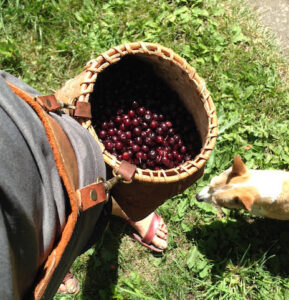Our 4-legged friends feel tension and nervousness just like we do. And some of the same botanical allies that work for us may help them, too. Three of the most popular calming remedies for us bipeds are also safe for your pooch when she’s having an off day: Chamomile, Valerian and Passionflower.
Chamomile (Matricaria recutita)
Peter Rabbit’s mother had it right. There’s nothing like some chamomile tea after a stressful day. Chamomile is a popular ingredient in many commercially-available calming dog chews.
•Irritability – For example, a snappy old dog
•Hyperactivity – The “super spaz” dog that won’t settle down
•Anxiety, fear – Especially if this is putting them off their food or causing digestive upset
Passionflower (Passiflora incarnata)
Passionflower is lovely for dogs with separation anxiety. I temporarily took in a super sweet dog that appeared to be lost after he hung around the yard for a couple hours. He looked like he’d been out of doors for a long time. Luckily, he had a collar with a tag that listed a local vet, though no owner information. I called the vet to have them reach out to the owner. While waiting to hear back, I went into town for an hour or so. The owner called while I was out and warned me to, under no circumstances, leave the dog alone in the house because of separation anxiety. He did, indeed, try to eat his way out of the house. To this day, I wonder if a little passionflower would have spared all my window frames.
•Separation anxiety
•Fear-based aggression
•For acute situations, not as a life long tonic
Valerian (Valeriana officinalis)
I used this for my old lab mix, Zoe. She was suffering from acute dizziness…staggering around with the characteristic head tilt of a vestibular disturbance. (The part of the inner ear that regulates balance). The vet confirmed that she did, indeed, have “Old Dog Disease” as this is sometimes called. Zoe was pretty distressed, panting and unable to relax. Valerian did the trick and she would calm down and curl up on her bed rather than stagger around and pant.
•Anxiety from thunderstorms, nail clipping, vet trips and other acute situations
•Tension from pain or discomfort
•Irritability
How to use herbs for your dog?
You can use herbs as a tea. Tea can be made ahead of time and stored in the fridge for up to a few days. Or use freshly ground herb powder. You can grind multiple doses-worth, just be aware that well-stored powdered herbs only maintain their activity for a few months.
I use regular old liquid extracts for my dogs. I’m not worried about the small amount of alcohol they’re getting. Folks who want to avoid alcohol in their pets can use glycerites instead (plant extracts made with vegetable glycerin). These will taste sweet, making canine compliance better if you’ve got a picky pooch.
You can add any of these to your dog’s food or, in the case of liquid extracts or glycerites, to a treat. Any of these preparations can be added to the water bowl, though dosing is harder to control and picky dogs may not want to drink water spiked with not-so-tasty bitter herbs like valerian. Also, not all herbs that are safe for dogs are safe for cats, so if there are cats in the house that share the water bowl use another dosing method.
How much do you use for your pup?
The rule of thumb many herbalists use is to divide the weight of an “average” human (150 lbs) by your dog’s weight. Use the resulting “dilution factor” to divide into the normal human dose. Say you want to use Chamomile tea for your 50 pound lab retriever. 150 lbs divided by 50 lbs equals 3. A reasonable human dose of Chamomile tea is 1 cup (8 oz). 1 cup divided by 3 is 1/3 of a cup (or 2.7 oz) for the dog.
Parting notes
As you would do for yourself, be sure to use good quality herbs from reputable sellers. Otherwise, in the least the herb might not be effective. In the worst case, the herb might not be what the label says. Also, if your dog is on many meds, talk to your vet or even a pharmacist or local herbalist before adding in an herb.
Like herbs for people, you may have to experiment with different calming herbs for your dog. For instance, chamomile didn’t phase my lab mix Zoe when she got into anxiety mode (usually on car rides)…she’d keep panting away and would remain standing the whole trip. Valerian (more on this momentarily) was the ticket.
~~~
Content © Dr. Anna Marija Helt, Osadha Natural Health, LLC. Permission to republish any of the articles or videos in full or in part online or in print must be granted by the author in writing.
The articles and videos on this website for educational purposes only & have not been evaluated by the Food and Drug Administration. This information is not intended to diagnose, treat, cure, or prevent any disease or to substitute for advice from a licensed healthcare provider.
Further Reading
Tilford, G & ML Wulff-Tilford (1999) All you ever wanted to know about herbs for pets. BowTie Press, Irvine, CA
